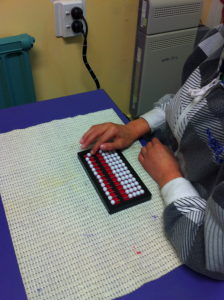Boston is learning how to use an abacus to support the development of both maths concepts and calculation skills.
Boston is using a Cranmer abacus because it has proved itself to be a useful whole of life tool for people who are blind or who have low vision.
Karen Gilligan (BLENNZ Resource Teacher Vision) describes how she introduced Boston to the Cranmer abacus (fig.1) and the first activities and strategies she has used to support Boston’s learning.
Recognising single and double digit numbers
Boston is learning to identify single and double digit numbers on an abacus. In figure 2 Boston is ‘setting 5 and clearing 4’ on the abacus while he is counting to 9. He is learning to use column 1 on the abacus and set and clear beads one at a time.
Using mathematical language
As maths has its own technical language, we needed to make sure that Boston had a thorough understanding of some common terms that we would need to use. The first word we explored was “digit”. We discussed that 0-9 are known as digits and how these make up all numbers. We also introduced the word “column”.
Where to next?
- To introduce Boston to the words: ‘set’ and ‘clear’.
- To ‘set’ and ‘clear’ single and double digit numbers on the abacus.
- To set and clear lower beads with right thumb.
- To set and clear bead above the bar with right index finger.
- To add double digit numbers using the abacus.
- To learn the indirect methods of addition.
Introduction of the abacus
I introduced the abacus to Boston in short intervals of 5-10 minutes during each weekly visit to his class. In figure 3 Boston is having a close look at the abacus.
- I have used the ‘logic method’ where Boston is learning to add numbers together by using number facts up to 10.
- I encourage Boston to say his thinking out loud as he counts or adds numbers together.
- An abacus was provided for Boston to use in the classroom during the week.
- Following some 1:1 training, the teacher’s aide was provided with information and activities to support the development of Boston’s abacus skills.
Learning adaptations
- We worked in a separate room to minimize distractions.
- We used a white non-slip mat under the abacus to keep it more stable and to make it more visible as Boston has a small amount of usable vision.
Assessment
During our twice weekly session, we evaluate Boston’s understanding and use of new skills using an abacus skills checklist from the Hadley School for the Blind. This information is shared with Boston’s class teacher and informs Boston’s classroom programme in maths.
Useful Links
- How to move the abacus beads – video on TSBVI Youtube channel.
- Using unit beads on the abacus – video on TSBVI YouTube channel.
- The Logic method – TSBVI website. Detailed information on this teaching strategy.
Learning resources
- Abacus intro video for low vision students – Teacher Tube Maths channel on YouTube.
- Indirect Addition Procedures: Abacus for the Blind – Flashcards and audio from Quizlet website.
More information
Email us at BLENNZ Online for more information about this subject.
We will link you up with either the author of this post or another BLENNZ colleague with whom you can continue your conversation.



